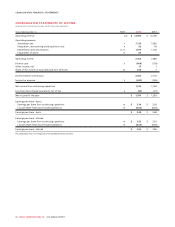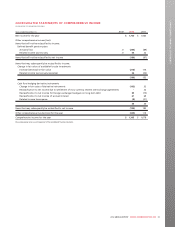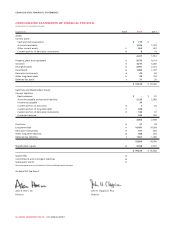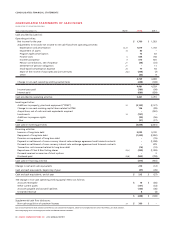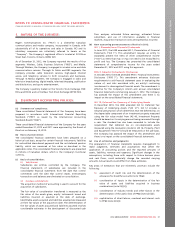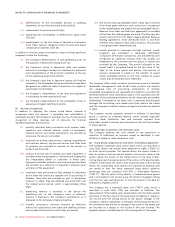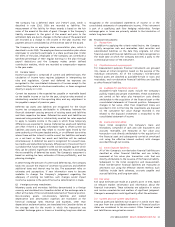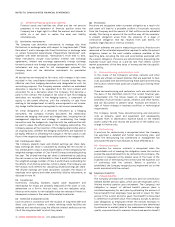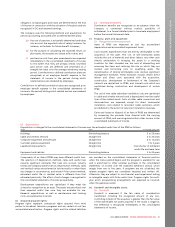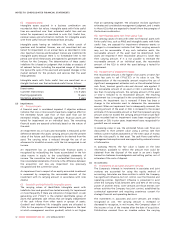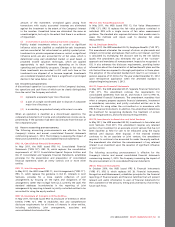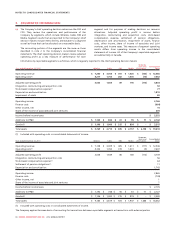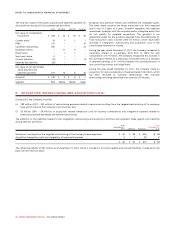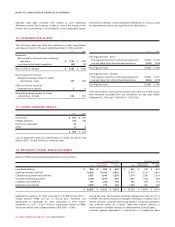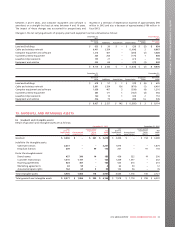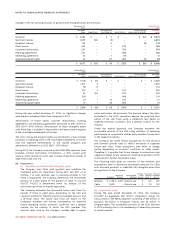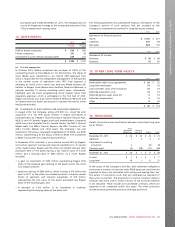Rogers 2012 Annual Report Download - page 96
Download and view the complete annual report
Please find page 96 of the 2012 Rogers annual report below. You can navigate through the pages in the report by either clicking on the pages listed below, or by using the keyword search tool below to find specific information within the annual report.
NOTES TO CONSOLIDATED FINANCIAL STATEMENTS
(ii) Intangible assets:
Intangible assets acquired in a business combination are
recorded at their fair values. Intangible assets with finite useful
lives are amortized over their estimated useful lives and are
tested for impairment, as described in note 2(u). Useful lives,
residual values and amortization methods for intangible assets
with finite useful lives are reviewed at least annually.
Intangible assets having an indefinite life, which consist of
spectrum and broadcast licences, are not amortized but are
tested for impairment on an annual basis, as described in note
2(u). Spectrum licences and broadcast licences are indefinite life
intangible assets because there is no foreseeable limit to the
period over which these assets are expected to generate net cash
inflows for the Company. The determination of these assets’
indefinite life is based on judgment that includes an analysis of
all relevant factors, including the expected usage of the asset,
the typical life cycle of the asset and anticipated changes in the
market demand for the products and services that the asset
helps generate.
Intangible assets with finite useful lives are amortized on a
straight-line basis over their estimated useful lives as follows:
Brand names 7 to 20 years
Customer relationships 3 to 5 years
Roaming agreements 12 years
Marketing agreements 3 years
(u) Impairment:
(i) Financial assets:
A financial asset is considered impaired if objective evidence
indicates that one or more events have had a negative effect on
the estimated future cash flow of that asset that can be
estimated reliably. Individually significant financial assets are
tested for impairment on an individual basis. The remaining
financial assets are assessed collectively based on the nature of
the asset.
An impairment loss on loans and receivables is measured as the
difference between the assets carrying amount and the present
value of the future cash flows expected to be derived from the
asset. The carrying value is reduced through the use of an
allowance for doubtful accounts, with the loss recognized in net
income.
An impairment loss on available-for-sale financial assets is
recognized by reclassifying the losses accumulated in the fair
value reserve in equity to the consolidated statements of
income. The cumulative loss that is reclassified from equity to
the consolidated statements of income is the difference between
the acquisition cost less any impairment loss previously
recognized and the current fair value.
An impairment loss in respect of an equity-accounted investment
is measured by comparing the recoverable amount of the
investment with its carrying amount in accordance with note
2(u)(iv).
(ii) Goodwill and indefinite-life intangible assets:
The carrying values of identifiable intangible assets with
indefinite lives and goodwill are tested annually for impairment
or more frequently if there are indicators of impairment. A cash
generating unit (“CGU”) is the smallest identifiable group of
assets that generates cash inflows that are largely independent
of the cash inflows from other assets or groups of assets.
Goodwill and indefinite life intangible assets are allocated to
CGUs for the purpose of impairment testing based on the level
at which management monitors goodwill, which is not higher
than an operating segment. The allocation involves significant
estimates and considerable management judgment, and is made
to those CGUs that are expected to benefit from the synergies of
the business combination.
(iii) Non-financial assets with finite useful lives:
The carrying values of CGUs with other non-financial assets with
finite useful lives, such as PP&E and intangible assets with finite
useful lives, are assessed for impairment whenever events or
changes in circumstances indicate that their carrying amounts
may not be recoverable. If any such indication exists, the
recoverable amount of the asset must be determined. Such
assets are impaired if their recoverable amount is lower than
their carrying amount. If it is not possible to estimate the
recoverable amount of an individual asset, the recoverable
amount of the CGU to which the asset belongs is tested for
impairment.
(iv) Recognition of impairment charge:
The recoverable amount is the higher of an asset’s or CGU’s fair
value less costs to sell (“FVLCTS”) or its value in use. The
determination of the recoverable amount requires the use of
significant management estimates such as the estimated future
cash flows, terminal growth rate and discount rate applied. If
the recoverable amount of an asset or CGU is estimated to be
less than its carrying amount, the carrying amount of the asset
or CGU is reduced to its recoverable amount. The resulting
impairment loss is recognized in the consolidated statements of
income. An impairment loss is reversed if there has been a
change in the estimates used to determine the recoverable
amount. When an impairment loss is subsequently reversed, the
carrying amount of the asset or CGU is increased to the revised
estimate of its recoverable amount so that the increased carrying
amount does not exceed the carrying amount that would have
been recorded had no impairment losses been recognized for
the asset or CGU in prior years. Impairment losses recognized for
goodwill are not reversed.
In assessing value in use, the estimated future cash flows are
discounted to their present value using a pre-tax rate that
reflects current market assessments of the time value of money
and the risks specific to that asset. The cash flows used reflect
management assumptions and are supported by external sources
of information.
In assessing FVLCTS, the fair value is based on the best
information available to reflect the amount that could be
obtained from the disposal of the asset in an arm’s length
transaction between knowledgeable and willing parties, net of
estimates of the costs of disposal.
(v) Investments:
(i) Investments in associates and joint ventures:
The Company’s interests in investments in associates and joint
ventures are accounted for using the equity method of
accounting. Associates are those entities in which the Company
has significant influence, but not control, over the financial and
operating policies. Significant influence is presumed to exist
when the Company holds between 20% and 50% of the voting
power of another entity. Joint ventures are those entities over
whose activities the Company has joint control, established by
contractual agreement and requiring unanimous consent for
strategic financial and operating decisions.
The investments in associates and joint ventures are initially
recognized at cost. The carrying amount is increased or
decreased to recognize, in net income, the Company’s share of
the income or loss of the investee after the date of acquisition.
Distributions received from an investee reduce the carrying
92 ROGERS COMMUNICATIONS INC. 2012 ANNUAL REPORT


